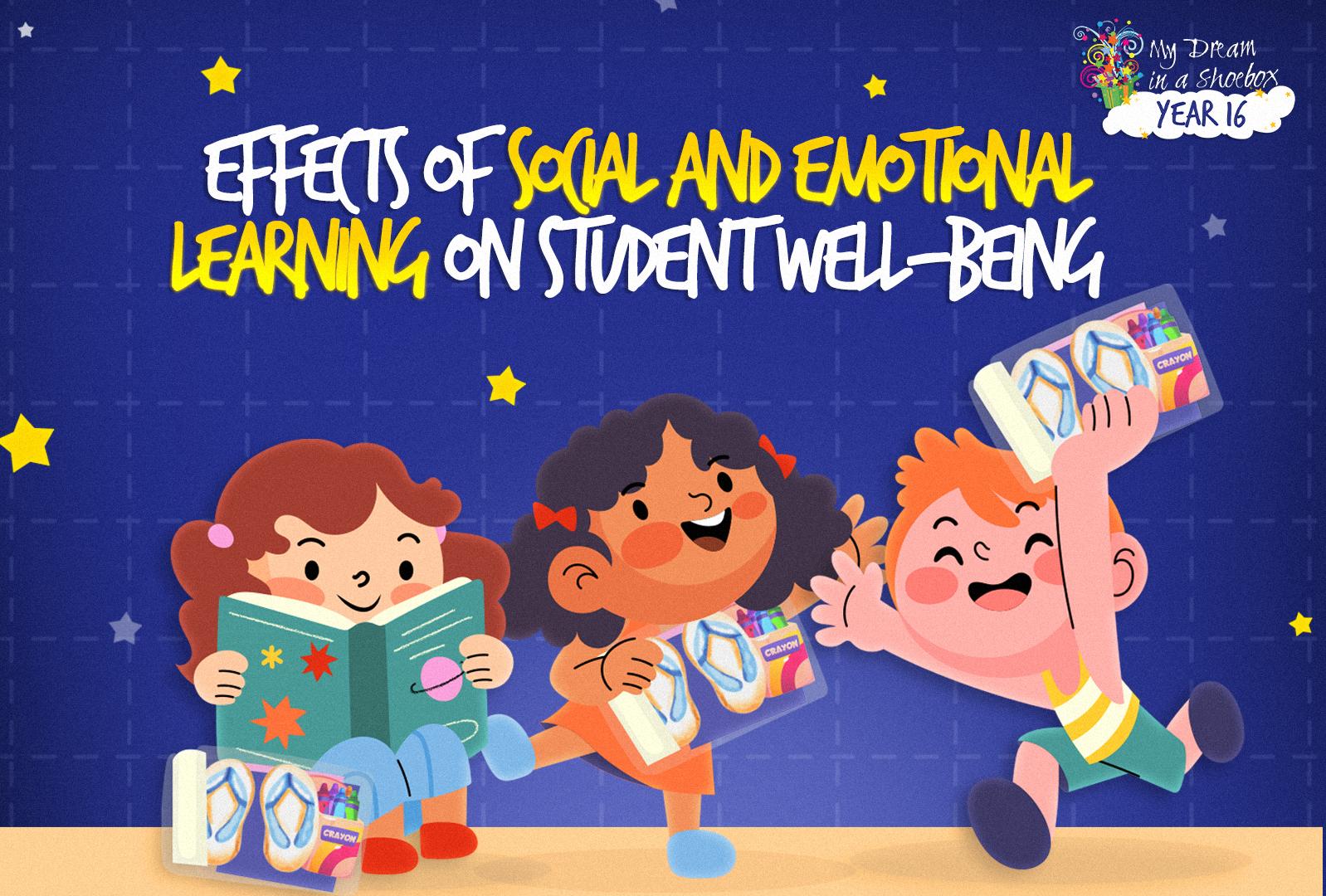Effects of Social and Emotional Learning on Student Well-Being

Students today need more than just academic knowledge, they also need social and emotional skills to succeed in school and life.
Social and Emotional Learning (SEL) supports both young learners and adults by enhancing self-awareness, improving academic performance, and encouraging positive behavior in school and beyond. Research shows that students involved in SEL programs experience an 11-percentile boost in overall academic performance and improved school attendance.
My Dream in a Shoebox volunteers see many families who need school materials during the many gift-giving days. Still, they also see a community that supports their children and their education. The community, school, and family play crucial roles in SEL.
As children grow, they face different challenges, from managing stress to making friends and making responsible decisions. Supporting their social and emotional development helps them better understand themselves and others, build healthy relationships, and make thoughtful choices. This is where Social and Emotional Learning (SEL) plays a key role.
At its heart, SEL is about equipping students with the essential life skills needed to thrive. It’s about helping them recognize their feelings, understand the perspectives of others, manage stress, build healthy connections, and make thoughtful choices. Think of it as providing them with a toolkit for navigating the social and emotional landscape of their lives, both inside and outside the classroom. When these skills are nurtured, the positive effects of social and emotional learning on student well-being are profound and far-reaching.
Let’s delve into some tangible ways SEL impacts the lives of young students:
1. Finding Their Inner Compass: Understanding and Managing Emotions
A young elementary student encounters a difficult math problem, leading to intense frustration. Without social-emotional learning (SEL) skills, this frustration might escalate into a tantrum, resulting in classroom disruption and feelings of inadequacy. However, with SEL, the student develops the ability to identify this feeling as frustration and understand that it’s a normal human emotion.
Consequently, they can utilize coping strategies such as taking a deep breath or asking for help. This capacity to recognize and manage emotions is essential for their overall well-being. It empowers them to approach challenges with resilience rather than being overwhelmed by them.
They learn that feelings are temporary and that they have the agency to respond in constructive ways. This development of self-awareness and self-management forms a strong foundation for emotional stability and significantly contributes to their overall happiness.
2. Building Bridges, Not Walls: Fostering Positive Relationships
The school serves as a central social hub, and the quality of a student’s relationships profoundly affects their well-being. SEL provides students with the necessary skills to establish and nurture positive connections with their peers, teachers, and family. They gain an understanding of empathy – the ability to recognize and share the emotions of others.
Furthermore, they develop crucial communication skills, allowing them to articulate their needs effectively and actively listen to others. They learn the importance of cooperation, how to resolve disagreements peacefully, and how to respect different viewpoints. Consider a situation where two students disagree on a collaborative project.
Equipped with SEL skills, they can communicate their opinions respectfully, comprehend each other’s perspectives, and work together to find a resolution. This competence in navigating social interactions effectively diminishes feelings of isolation, cultivates a sense of belonging, and fosters a supportive atmosphere where students feel valued and connected, thereby directly enhancing their social well-being.
3. Making Good Choices: Developing Responsible Decision-Making
Throughout their day, students encounter numerous choices, ranging from how to react to a classmate’s teasing to deciding whether to follow classroom rules. SEL cultivates responsible decision-making by guiding students to think about the potential outcomes of their actions, understand ethical principles, and make choices that reflect their values and the well-being of others.
Consider a student who is tempted to cheat on a test. With strong SEL skills, they are more likely to consider the unfairness to their peers, the possible repercussions if they are caught, and the fundamental importance of honesty. They learn to evaluate different options and make choices that not only benefit themselves but also show respect for others.
This sense of responsibility, coupled with the ability to make sound judgments, contributes to a feeling of control and self-assurance, further improving their overall well-being and guiding them towards positive behavior and ethical conduct.
These three aspects – emotional regulation, positive relationships, and responsible decision-making – are deeply interconnected and form the bedrock of a student’s social and emotional health. When students develop these skills, they are better equipped to handle stress, navigate social complexities, build supportive networks, and make choices that lead to positive outcomes. The effects of social and emotional learning on student well-being ripple through every aspect of their lives, contributing to a more positive and fulfilling school experience and laying the groundwork for success in their future endeavors.
Beyond these core areas, SEL also cultivates crucial skills like resilience – the ability to bounce back from setbacks – and a growth mindset – the belief that abilities can be developed through dedication and hard work. These qualities are vital for navigating the inevitable challenges of life and contribute significantly to a student’s overall sense of well-being and their ability to persevere in the face of difficulty.
Empowering Students: How Can We Help Them Thrive?
Creating an environment where SEL flourishes requires a collective effort. Educators can integrate SEL into their lessons and classroom management practices, explicitly teaching these skills through engaging activities, discussions, and modeling. Parents play a crucial role by reinforcing these skills at home, fostering open communication about emotions, and providing opportunities for their children to practice empathy and problem-solving. Communities can also contribute by supporting initiatives that promote social and emotional development in young people.
One vital way to empower students and foster their well-being is by ensuring they have access to the fundamental tools for learning. Imagine a student eager to participate but lacking basic school supplies, feeling marginalized and unable to fully engage. This is where the incredible work of organizations like My Dream in a Shoebox comes in.
By supporting My Dream in a Shoebox, you directly contribute to the well-being of underprivileged students by providing them with the resources they need to thrive academically and, consequently, emotionally. When students have the necessary tools and a supportive learning environment, they feel more confident, capable, and connected, fostering a stronger sense of well-being.
My Dream In A Shoebox
By donating to My Dream in a Shoebox, you wield the ability to select the avenue through which you’d like to make a difference:
- Dream Kits are filled with essential school supplies, tools, and resources crucial for a student’s educational journey.
- Educational Hubs with functional laptops equipped with reliable internet connectivity and printing facilities.
- Sponsoring a scholar’s education for an entire year, laying the foundation for their academic success.
Investing in Social and Emotional Learning and providing essential resources are not separate endeavors; they are intertwined pathways to nurturing the holistic well-being of our students. By understanding the profound effects of social and emotional learning on student well-being and supporting initiatives that empower young learners, we can collectively build a brighter future where every child has the opportunity to flourish, both academically and emotionally.

 facebook.com/mydreaminashoebox
facebook.com/mydreaminashoebox instagram.com/mydreaminashoebox
instagram.com/mydreaminashoebox